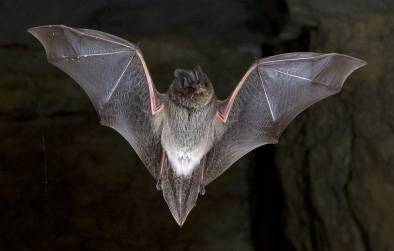
Photo © C. Robiller
The western barbastelle (Barbastella barbastellus), also known as the barbastelle or barbastelle bat, is a European bat in the genus Barbastella. This species is found from Portugal to Azerbaijan and from Sweden to Canary Islands, where a sub-species was identified. It has a short nose, small eyes and wide ears. The conservation status of B. barbastellus is assessed as "near threatened", "vulnerable", "critically endangered" or "extinct" in various parts of its range.
The western barbastelle was described as a new species in 1774 by Johann Christian Daniel von Schreber, who placed it in the genus Vespertilio, with a species name of Vespertilio barbastellus. The holotype had been collected in Burgundy, France. In 1836 it was placed in the genus Barbastellus, and the first use of its current name combination of Barbastella barbastellus was in 1897 by Gerrit Smith Miller Jr. The name Barbastella barbastellus might be coming from the Latin barba (beard) and stella (star). Viewed from the side, it seems that the upper lip has a beard, or a moustache.
Two subspecies are recognized by Mammal Species of the World (2005):
In addition to morphological measurement, DNA analysis confirmed the presence of an endemic sub-species in the Canary Islands as well as a relatively homogeneous genetic structure among populations of the Iberian Peninsula and Morocco, and probably, across Europe as far as the Thrace region.
The barbastelle is a medium-sized bat, with a characteristic pug-shaped nose. The ears are broad, joined across its head by skin, and covered in gingery-brown fur on the rear surface. The tragus is triangular – broad at the base but with a nearly parallel tip which starts about halfway along its length. Head and body length is between 40 and 55 mm and wingspan is between 26 and 29 cm (10 and 11 in). Forearm length is 3.5 to 4.5 cm (1.4 to 1.8 in) and body mass is 6 to 13 g (0.21 to 0.46 oz).
Barbastelles roost in splits or behind loose bark of trees all year, generally in mature deciduous forests, as well as rock crevices and within human buildings. In central Italy, tall dead beech in unmanaged woodland were found to be preferred as roost trees. While barbastelles typically remain within a single roosting area, they move between individual roosts with great frequency.
Barbastelles migrate to underground roosting sites over the winter, although they may stay within arboreal roosts in the beginning of the season. Winter roosting sites include natural caves and human structures such as basements, mines and bunkers. Barbastelles are relatively resistant to cold conditions, and are typically found hibernating in cold sites and in exposed positions.
Barbastelles feed chiefly on moths, as well as on flies. Research from Switzerland showed that the biologically most productive parts of the forest are exploited in priority by this species while hunting and that ca. 99% of prey by volume consisted of Lepidoptera. More recent studies confirmed this predominance of Lepidoptera, underlining that medium-sized and larger specimens are targeted in priority by the barbastelles. However, seasonal diet changes were recorded during autumn due to potential interspecific competition with Plecotus austriacus and strong decrease of flying larger moths.
The diet of the barbastelles appears to be one of the narrowest among European bats. This specialization in foraging habits probably points to a higher vulnerability of this species to negative changes in the abundance of moth populations. This could explain its current rarity throughout most of its range.
While foraging, barbastelles behave as typical aerial-hawking bat species despite the fact that they hunt exclusively just above the forest canopy. This peculiar foraging technique could be explained by the co-evolution with the defence system of its prey.
Specimens can travel up to 20 km per night for foraging purposes and nonreproductive females forage at greater distances than reproductive females
Individuals reach their sexual maturity after one or two years. After total sexual segregation during most of spring and summer, the mating period starts at the end of summer, sometimes during swarming episodes. The mating period is often finishing with the start of the hibernation, but some cases of late mating during winter and early spring have been observed Around May–June, each pregnant female gives birth to one or two newborn juveniles which she breastfeeds up to 6 weeks.
The barbastelle has two main call types used for echolocation. The frequency parameters of call type 1 lie between 30 and 38 kHz, have most energy at 33 kHz and have an average duration of 2.5 ms. The frequency parameters of call type 2 lie between 29 and 47 kHz, have most energy at 38 kHz and have an average duration of 4.1 ms.
This species is rare and most of the time decreasing throughout its range. Some historical data from the 19th century refers to the presence of western barbastelles in Senegal. This data is considered as doubtful.
This species is protected in the European Union under the Habitats Directive, meaning that habitats and roosts use by this species may be considered for notification as a Site of Special Scientific Interest. This species is also listed in the Berne Convention and is specifically targeted by the UNEP-EUROBATS convention. Several national legislation are also protecting this species and its habitats in many countries and regions.
In order to highlight the importance of protecting this species at the European scale, this species was selected as bat species of the Year 2020-2021 by the pan-European NGO BatLife Europe.
This species is classified as near threatened (NT) in the worldwide IUCN Red List, while it is considered as vulnerable (VU) at the European and European Union scale and near threatened (NT) in the Mediterranean Red List.
Source: Wikipedia